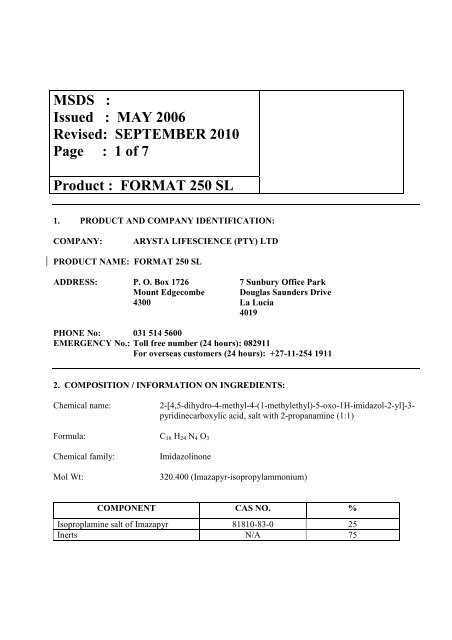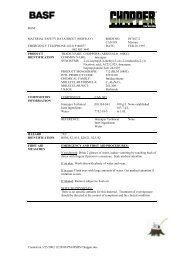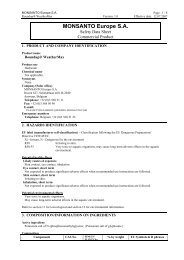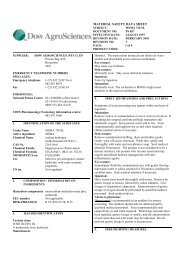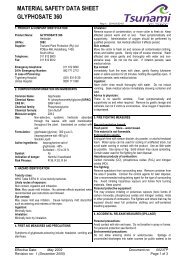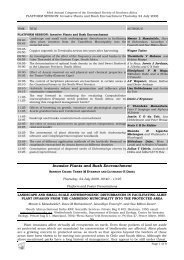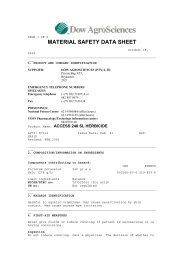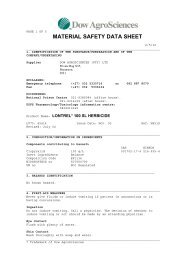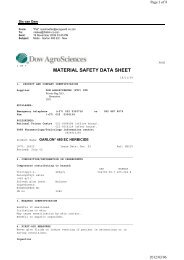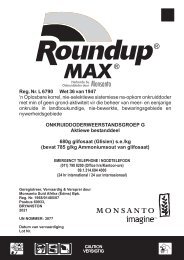MSDS FORMAT250 SL - Bush Encroachment
MSDS FORMAT250 SL - Bush Encroachment
MSDS FORMAT250 SL - Bush Encroachment
You also want an ePaper? Increase the reach of your titles
YUMPU automatically turns print PDFs into web optimized ePapers that Google loves.
<strong>MSDS</strong> :Issued : MAY 2006Revised: SEPTEMBER 2010Page : 1 of 7Product : FORMAT 250 <strong>SL</strong>1. PRODUCT AND COMPANY IDENTIFICATION:COMPANY:ARYSTA LIFESCIENCE (PTY) LTDPRODUCT NAME: FORMAT 250 <strong>SL</strong>ADDRESS: P. O. Box 1726 7 Sunbury Office ParkMount Edgecombe Douglas Saunders Drive4300 La Lucia4019PHONE No: 031 514 5600EMERGENCY No.: Toll free number (24 hours): 082911For overseas customers (24 hours): +27-11-254 19112. COMPOSITION / INFORMATION ON INGREDIENTS:Chemical name:2-[4,5-dihydro-4-methyl-4-(1-methylethyl)-5-oxo-1H-imidazol-2-yl]-3-pyridinecarboxylic acid, salt with 2-propanamine (1:1)Formula: C 16 H 24 N 4 O 3Chemical family:Mol Wt:Imidazolinone320.400 (Imazapyr-isopropylammonium)COMPONENT CAS NO. %Isoproplamine salt of Imazapyr 81810-83-0 25Inerts N/A 75
<strong>MSDS</strong>: FORMAT 250 <strong>SL</strong>Issued: MAY 2006Revised: September 2010Page: 3 of 76. ACCIDENTAL RELEASE MEASURES:Personal precautions:Environmentalprecautions:Methods for cleaning up:Respiratory Protection: Supplied air respirators should be worn iflarge quantities of mist/dust are generated or prolonged exposurepossible.Eye protection: Chemical goggles when respirator does not provideeye protection.Protective clothing: Gloves and protective clothing as necessary toprevent skin contact.Ventilation: Whenever possible, engineering controls should be used tominimize the need for personal protective equipment.In case of large spillage of this product, avoid contact, isolate area andkeep out animals and unprotected persons. For small spills wearpersonal protective equipment as specified by the label.For a liquid spill: Dike and contain the spill with inert material (sand,earth, etc.,) and transfer the liquid and solid Diking materials to separatecontainer for disposal.Pesticide wastes are actually hazardous. Wastes resulting from theproduct may be disposed of on site at an approved waste disposalfacility. Improper disposal of excess pesticide, spray mix or rinsate is aviolation of the South Africa law. If these wastes cannot be disposed ofaccording to label instructions, contact the state agency responsible forpesticide7. HANDLING AND STORAGE:Handling:Storage:Read the label before use. Avoid contact with skin and eyes.When using do not eat, drink or smoke.Wash face and hands before eating, drinking or smoking.Store in original container in cool, dry, well-ventilated area place awayfrom ignition sources, heat or flame. Do not store below -12.2 o C.
<strong>MSDS</strong>: FORMAT 250 <strong>SL</strong>Issued: MAY 2006Revised: September 2010Page: 4 of 78. EXPOSURE CONTROL / PERSONAL PROTECTION:Occupational exposure limits: TWA 0.5 mg/m 3 – BASF recommendedPERSONAL PROTECTIVE EQUIPMENT:Respirator:Supplied air respirators should be worn if large quantities of mist/dustare generated or prolonged exposure possible.Clothing and Gloves: Gloves and protective clothing as necessary to prevent skin contact.Eye protection:Chemical goggles when respirator does not provide eye protection.9. PHYSICAL AND CHEMICAL PROPERTIES:Appearance:Clear brown to amber liquidOdour:AmineExplosive properties: NoneFlash point:> 93 o COxidising properties: NopH: 5.5-7.5Relative density: 1.07 ± 0.01g/ml @ 20 o CSolubility in water: SolubleStorage stability: Stable if stored 10˚F = - 12.2˚C. See 7.2 which indicates that theproduct should not be stored below 10˚F.10. STABILITY AND REACTIVITY:Stability:Incompatability:Stable, but do not store below –12.2ºCOxidising agents and reducing agentsHazardous decomposition: Including but not limited to oxides of carbon and nitrogen.11. TOXICOLOGY INFORMATION:Acute oral LD 5 0 :Rat (both sexes) > 5000 mg/kgAcute dermal LD 50 :Rabbit (both sexes) > 2000 mg/kgAcute inhalation LC 50 (4 h) Rat, no mortality > 1.58 mg/lAcute inhalation LC 50
<strong>MSDS</strong>: FORMAT 250 <strong>SL</strong>Issued: MAY 2006Revised: September 2010Page: 5 of 7(1 hr calculated): No mortality > 6.32 mg/lAcute inhalation toxicity (rat): > 5.1 mg/l (nominal),Acute skin irritation: IrritatingAcute eye irritation: Irritating to eye with recovery by day 3.Dermal sensitisation: Mild sensitizerCarcinogenicity: Not listedMutagenicity:No mutagenic activity was observed in Technical Imazapyr by all testmethods used.Teratogenicity:No teratogenic or fetotoxic effects were found at all dose levels tested inmice and rats.12. ECOLOGICAL INFORMATION:Residual Soil Activity:Adsorption:Imazapyr can remain active in the soil for 6 months to 2 years.Imazapyr is strongly adsorbed by soils.It is usually found only in the top few inches of soil.Persistence / Degradation: Imazapyr may be broken down by exposure to sunlight. Soilmicroorganisms contribute to the breakdown of Imazapyr.Very little Imazapyr is lost by evaporation.Soil Microorganisms:Birds (LD 50 ):Fish (LC 50 ):Daphnia (LC 50 ):Imazapyr has very little effect on microorganisms. Studies to determinethe effect of Imazapyr treatments on soil microorganisms show that thecompound has no adverse effect on numbers of soil organisms, growthrates of microbial populations, soil enzymes, nitrogen cycling, sulphuroxidation, mineralization of organic substrates or normal soil respiration.Imazapyr is practically non-toxic to birds.Acute oral LD 50 for bobwhite quail and mallard ducks >2150 mg/kg.Dietary LC 50 (8 d) for bobwhite quail and mallard ducks >5000 mg/kg.Imazapyr is of low toxicity to fish and invertebrates.LC 50 (96 h) for rainbow trout, bluegill sunfish, and channel catfish >100mg/l.LC 50 (48 h) >100 mg/l.
<strong>MSDS</strong>: FORMAT 250 <strong>SL</strong>Issued: MAY 2006Revised: September 2010Page: 6 of 7Algae:Bees:It has a low toxicity algae 7-Day EC 50 : Freshwater blue-green alga(Anabaena flos-aquae): 11.7 mg/lFreshwater green alga (Selenastrum capricornutum): 71.0 mg/lIt is of low toxicity to bees. Dermal LD 50 for honeybees >100 mg/bee.13. DISPOSAL CONSIDERATIONS:Pesticide disposal:Wastes resulting from the product may be disposed of on site at an approved waste disposal facility.Improper disposal of excess pesticide, spray mix, or rinsate is a violation of the federal law. If thesewastes cannot be disposed of according to label instructions, contact the state agency responsible forpesticide regulation.Package product wastes:For plastic containers: Triple rise (or equivalent) and rinsate to spray tank. Then offer recyclingor reconditioning, or puncture and dispose of in a sanitary landfill, or by incineration, or if allowedby state and local authorities, by burning. If burned, stay out of smoke.For bulk containers: Reusable containers should be returned to the point of purchase for cleaningand re-filling.For mini bulk containers: Clean all tanks on an approved loading pad so rinsate can be collected andmixed into the solution or in a dedicated tank. Using a high-pressure sprayer, rinse several times withsmall amounts of water to minimize rinsate.14. TRANSPORT INFORMATION:UN No: Not regulated for transport.__________________________________________________________________________________15. REGULATORY INFORMATION:Symbol: XiIndication of danger: IrritantRisk phrases:R 36 Irritating to eyes.R 52/53 Harmful to aquatic organisms, may cause long-term adverse effects in the aquaticenvironment.Safety phrases:
<strong>MSDS</strong>: FORMAT 250 <strong>SL</strong>Issued: MAY 2006Revised: September 2010Page: 7 of 7S 2S 26S 61Keep out of the reach of children.In case of contact with eyes rinse immediately with plenty of water and seek medicaladviceAvoid release to the environment. Refer to special instructions/Safety data sheets.National legislation: In accordance with the South African National Road Traffic Act, 1996 (Act 93of 1996), the Fire Brigade Act, 1987 (Act 99 of 1987) and the Occupational Health and Safety Act,1993 (Act No. 85 of 1993).16. OTHER INFORMATION:FORMAT 250 <strong>SL</strong> is the property of ARYSTA LIFESCIENCE (PTY) LTDThe data in this Material Safety Data Sheet relates only to the specific material designatedherein and does not relate to use in combination with any other material or in any process. Allinformation is given in good faith but without guarantee in respect of accuracy, and noresponsibility is accepted for errors or omissions or the consequence thereof.REFERENCES• Similar product <strong>MSDS</strong>.• The Pesticide Manual; Eleventh Edition; Editor Clive Tomlin; Crop ProtectionPublications, 1997.• Dangerous Goods Regulations; IATA International Air Transport Association, 41stEdition, Effective 1 January 2000.• IMDG Code, Vol. 2, 2000 Edition/.• EXTOXNET, Pesticide Information Profiles, Revised June 1996. The primary files aremaintained and archived at the Oregon State University.


